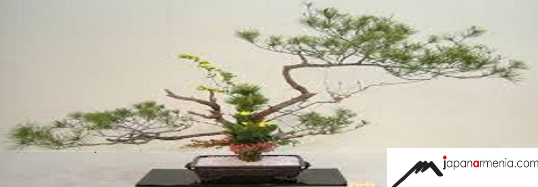
生け花の文化
November 5, 2009
According to the Japanese painters, the infinite beauty of the figures of flora finds its expression in the art of ikebana. It is the art of flower decoration or making bouquets, but not in an ordinary concept, it has a philosophy in itself. Ikebana has 800 years’ history. It was created in the Temple of Buddha by the clergymen. It is said that the Japanese women cannot marry unless they know the art of sewing, cooking and ikebana. Still at the age of 7 the Japanese girls are taught the art of making compositions. Simultaneously, in children they bring up the sense of harmony and perfection.
Ikebana is considered a principal and obligatory subject in female schools and colleges. In order to become specialists they study 3 years and 10 months, during which they get acquainted with painting, fragrance of flowers, colors, shades and morphology of plants. Each year in Tokyo, there are announced contests of ikebana.
One of the biggest and modern schools of ikebana is Sogetsu, one of the heads of which is Sofu Tashigahara. The basis of the Japanese bouquet make three main stem-symbols. According to the principles of ikebana, the longest from these three stems is sin, which symbolizes the sky and is a very important element in the composition, as the impression of the composition depends on its position and dynamics. The second stem – lyusin, symbolizes the human and is shorter than the first one. The third stem – hikae is the shortest one and symbolizes the earth.
When creating ikebana not only fresh flowers are used but also twisted and various dry branches of different plants on which there are dried fruits, various sprouts, roots and crusts, in short, all those natural means, with which artificial landscapes can be made.
The composition created is put on a special pedestal and has its holy corner, which is called tokonoma. The guest visiting a Japanese family first approaches tokonoma, carefully examines the ikebana trying to understand the mood of the host or hostess. If the guest feels the friendly mood of the host, he firstly bends down before the ikebana, then – before the host and then passes onto the daily talk, certainly emphasizing the impression got from the composition. And if the composition makes the guest feel that the host is in no mood, the guest is obliged to leave immediately.
According to the Japanese painters in the compositions and bouquets only flowers of odd numbers must be used and they should be arranged asymmetrically and in such a way that their tips should not rub each other.
The most common tree in Japan is pine-tree. The New Year compositions are made with the branches of pine-tree, which symbolize longevity, the branches of Indian cane, which symbolize durability and with colored candles.
Peach tree blossoms on March 3 in Japan. This day is celebrated as Girls’ Day and they are decorated with pink flowers of peach tree, which symbolize delicacy, innocence and beauty. The Children’s Day is celebrated on May 5. On this day, they wear branches of oak, which symbolize force, will and courage.
http://archive.168.am/am/articles/20508-prから取られた材料
translated from Armenian into English by M.Vardanyan










